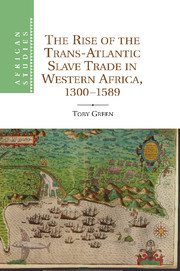Book contents
- Frontmatter
- Contents
- List of Maps
- Acknowledgements
- Abbreviations
- Glossary
- Introduction Rethinking the Trans-Atlantic Slave Trade from a Cultural Perspective
- Part One The Development Of An Atlantic Creole Culture In Western Africa, Circa 1300–1550
- Part Two Creolisation And Slavery
- 6 The Early Trans-Atlantic Slave Trade from Western Africa
- 7 Trading Ideas and Trading People
- 8 Cycles of War and Trade in the African Atlantic, circa 1550–1580
- 9 Creole Societies and the Pan-Atlantic in Late-Sixteenth-Century Western Africa and America
- Conclusion Lineages, Societies and the Slave Trade in Western Africa to 1589
- Bibliography
- Index
8 - Cycles of War and Trade in the African Atlantic, circa 1550–1580
from Part Two - Creolisation And Slavery
Published online by Cambridge University Press: 05 November 2011
- Frontmatter
- Contents
- List of Maps
- Acknowledgements
- Abbreviations
- Glossary
- Introduction Rethinking the Trans-Atlantic Slave Trade from a Cultural Perspective
- Part One The Development Of An Atlantic Creole Culture In Western Africa, Circa 1300–1550
- Part Two Creolisation And Slavery
- 6 The Early Trans-Atlantic Slave Trade from Western Africa
- 7 Trading Ideas and Trading People
- 8 Cycles of War and Trade in the African Atlantic, circa 1550–1580
- 9 Creole Societies and the Pan-Atlantic in Late-Sixteenth-Century Western Africa and America
- Conclusion Lineages, Societies and the Slave Trade in Western Africa to 1589
- Bibliography
- Index
Summary
A masquerade associated today with the circumcision ritual in the Casamance is called the kankuran. The night before the ceremony people gather in compounds and make percussive rhythms in fear of the morrow. In the morning, the kankuran prowls through the streets dressed in a fearsome mask and wielding a machete. People flee from him in terror. Whilst in Casamance, I was often told that the kankuran was a Mandinka phenomenon.
Some anthropologists with symbolist leanings have attempted to analyse various performative dances, masking traditions and magical rituals in West African contexts as memorialisations of the trans-Atlantic slave trade. In Sierra Leone, Rosalind Shaw argues that the magical discourse related to beliefs in invisibility and witchcraft stem from the very invisibility accorded to people who disappeared through that trade. In the grassfields of Cameroon, Nicolas Argenti sees echoes of forced marches of captives and of slave raids in dances associated with masking traditions. For the kankuran in Casamance, one could attempt something similar and ask whether the flight from the Mandinka kankuran may not represent a memorialisation of the flight from Mandinka slave raiders of the Gambia River states and Kaabu in the Atlantic era.
- Type
- Chapter
- Information
- Publisher: Cambridge University PressPrint publication year: 2011

